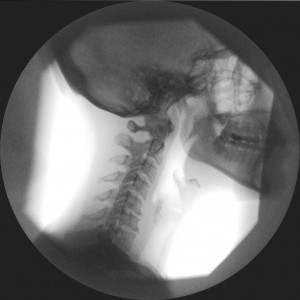
The mechanism for spinal manipulation in the treatment of pain is unknown. One mechanism proposed in the literature is that neck pain might be alleviated by changing or ‘correcting’ the alignment of the cervical spine (normal is considered to be a lordosis or lordotic curve – curving in towards the body). We decided to put this idea to the test in an undergraduate student project at AECC. Mike Shilton, a third year chiropractic student at the time, measured the angle of the cervical spine on x-ray images taken of patients and healthy volunteers that I had recruited for my PhD research. In that research, briefly, patients received spinal manipulation over 4 weeks, while healthy volunteers did not. Both groups had motion x-rays taken at baseline and 4-week follow-up. By using the first static image of each motion sequence we were able to investigate whether the cervical spine alignment or lordosis changed in the patient group, and whether such changes were greater than that in the healthy group not receiving treatment.
For the statistical analysis Mike was assisted by another student, Bas Penning de Vries. After the study it was proposed to the two students, by me and Professor Alan Breen, that they have a go at writing up the study for publication, with our assistance of course. Happily, they decided to do so. It might have been at times a painful process for them (most worthwhile things seem to be!), but they persevered and now it is published in a peer-reviewed open access journal! A great achievement for them, a publication already as they begin their clinical careers.
This co-created paper was a valuable exercise for the two undergraduate students, getting to learn about the research process, statistical analysis, publication and dissemination. An obvious benefit of co-creation to academics is that the workload of a project is spread throughout a larger team, albeit the students require support -but the time invested in that support should pay off. For instance, Mike and Bas brought a fresh perspective to the team, posing well considered questions and suggestions that could be taken on board to improve the robustness of my own work and lines of argument. And of course, we now have a publication that would have taken much longer to get to press had I not had their assistance in writing it. In other words, with co-creation, everyone stands to gain.











 New Nepal scoping review on maternal & neonatal health
New Nepal scoping review on maternal & neonatal health Fourth INRC Symposium: From Clinical Applications to Neuro-Inspired Computation
Fourth INRC Symposium: From Clinical Applications to Neuro-Inspired Computation Writing policy briefs
Writing policy briefs Upholding Excellence: The Concordat to Support Research Integrity
Upholding Excellence: The Concordat to Support Research Integrity ECR Funding Open Call: Research Culture & Community Grant – Application Deadline Friday 12 December
ECR Funding Open Call: Research Culture & Community Grant – Application Deadline Friday 12 December MSCA Postdoctoral Fellowships 2025 Call
MSCA Postdoctoral Fellowships 2025 Call ERC Advanced Grant 2025 Webinar
ERC Advanced Grant 2025 Webinar Horizon Europe Work Programme 2025 Published
Horizon Europe Work Programme 2025 Published Horizon Europe 2025 Work Programme pre-Published
Horizon Europe 2025 Work Programme pre-Published Update on UKRO services
Update on UKRO services European research project exploring use of ‘virtual twins’ to better manage metabolic associated fatty liver disease
European research project exploring use of ‘virtual twins’ to better manage metabolic associated fatty liver disease